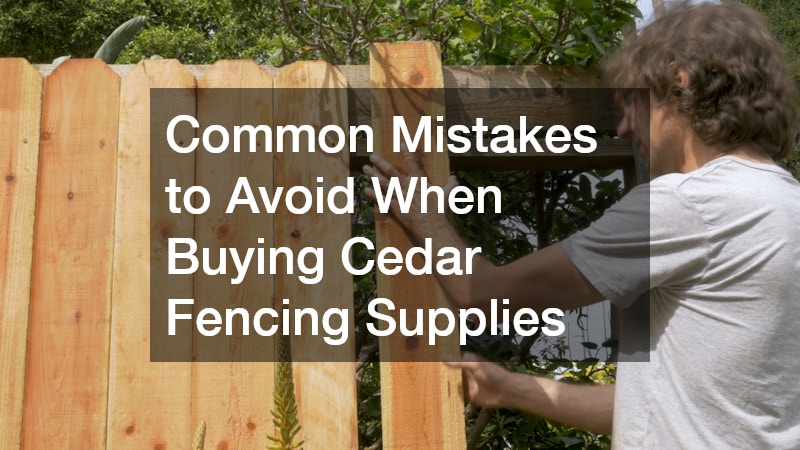In this article, we will explore common pitfalls that buyers encounter when purchasing cedar fencing supplies. Understanding these mistakes can save you time, money, and frustration while helping you choose the best materials for your fencing project.
What Type of Cedar Should You Choose for Fencing?
Selecting the right type of cedar is crucial. Different cedar species, such as Western Red Cedar or Northern White Cedar, offer varying levels of durability and aesthetic appeal.
Each species has distinct characteristics that affect its suitability for specific climates and uses. Understanding these differences will ensure you make a thoughtful choice that meets both your functional and visual expectations.
The Western Red Cedar is particularly valued for its natural resistance to decay and insect damage, making it an excellent option for fencing. Its rich color and pleasant aroma can add beauty to your landscape while providing long-lasting performance. On the other hand, Northern White Cedar is known for its lightweight properties and is suitable for areas with fluctuating temperatures, but it may not hold up as well in very moist conditions.
It’s equally important to consider the intended use of your fence when choosing cedar type. For instance, a fence designed for complete privacy may require thicker panels and specific grades to ensure durability and a finished look that suits your property. Therefore, the selection process should be thorough and take into consideration the unique needs of your project.
How to Assess the Quality of Cedar Fencing Supplies?
Quality grades of cedar can greatly affect the longevity and appearance of your fence. Higher-grade lumber typically features fewer knots and a more uniform color, which contributes to both structural integrity and aesthetic appeal. Being able to distinguish between the different grades available can save you money in the long run by preventing premature wear due to inferior materials.
When assessing cedar fencing supplies, look for boards that have minimal trunk knots and a consistent grain pattern. Additionally, inspecting the moisture content is essential; boards that are too wet can warp or crack as they dry, while those that are too dry may become brittle. Understanding these quality indicators will empower you to make educated decisions at the hardware store or lumber yard.
Another factor to consider is the treatment process the wood has undergone. Untreated cedar may seem appealing initially, but factors like excessive moisture exposure could lead to significant deterioration over time. Choosing treated cedar can enhance its resistance to rot and pests, ensuring your fencing lasts much longer and requires less maintenance.
What Are the Most Common Sizing Errors When Buying Cedar Fencing?
Incorrect sizing can lead to structural issues in your fencing. When you don’t take measurements carefully, you risk ending up with materials that don’t fit or work well for your intended design. Taking the time to measure your space accurately can save you from having to deal with the complications that arise from wrong-sizing, such as additional costs or a compromised fence structure.
Standard dimensions vary for different types of cedar fencing panels, and familiarizing yourself with these standards before purchase can help streamline the selection process. Always account for the spacing between posts and panels; failing to do this can compromise stability and let in more elements, such as wind and sunlight, which may damage the fence over time.
Additionally, remember that a fence built with uneven panels can lead to unsightly gaps and diminish your property’s curb appeal. Planning and plotting out your layout on paper can assist you in visualizing how your sizing decisions will come together. Accurate measurements will allow your fence building process to progress more smoothly and yield better results.
Why Is It Important to Consider Local Climate When Buying Cedar Fencing?
Cedar’s performance can vary based on local weather conditions. In areas with high humidity, untreated cedar can swell and develop mold, while extremely dry climates might cause it to crack and warp. Considering your local climate can help you choose the appropriate treatment and maintenance methods that are best suited for your location.
For example, in a coastal region where saltwater exposure is common, choosing a highly resistant type of cedar and applying protective coatings will be essential. Similarly, areas prone to heavy rainfall may benefit from regular maintenance routines like sealing or staining. Adapting your fencing choice to the climate is key to ensuring longevity and preserving the integrity of the wood.
Moreover, understanding climate effects can prevent you from selecting supplies that are inadequately equipped to handle your environment. Fencing that remains in constant contact with wet ground may need specific types of soil treatment or base installation to avoid rot. Taking your time to consider these climatic influences provides a strong foundation for your cedar fencing project.
By avoiding these common mistakes, you can ensure that you invest in quality cedar fencing supplies that align with your fencing goals. Taking the time to research and plan will ultimately lead to a successful and durable fencing project.


